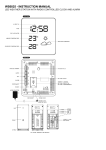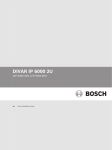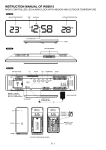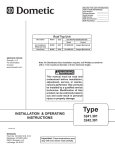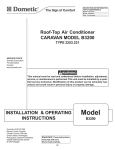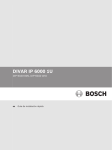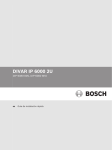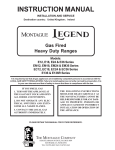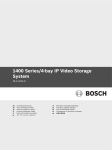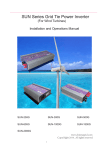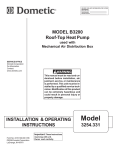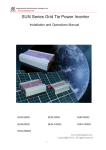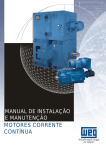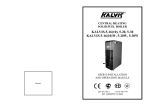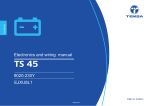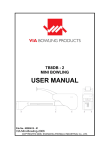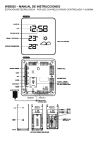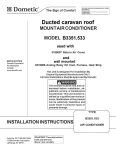Download INSTALLATION & OPERATING INSTRUCTIONS
Transcript
RECORD THIS UNIT INFORMATION FOR FUTURE REFERENCE: Type Number Product Number Serial Number ADB Number ADB Serial Number Date Purchased Roof Top Unit Description Model Type Use With Air Distribution Box Model Supplied by Dometic Australia contact www.dometic.com.au Air Conditioner W/Electric Heat B3200 3241CX51R 3311669.018CY2 Heat Pump B3200 3242CX51R 3311669.018CY1 Note: Air Distribution Box installation requires a #2 Phillips screwdriver with a 7 mm maximum diameter x 35 mm minimum length. This manual must be read and understood before installation, adjustment, service, or maintenance is performed. This unit must be installed by a qualified service technician. Modification of this product can be extremely hazardous and could result in personal injury or property damage. INSTALLATION & OPERATING INSTRUCTIONS REVISION Form No. 54-AA-MA3200CY1 MOBICOOL Electronic(Zhuhai)Co., Ltd 18, Jinhu Lu, Sanzao, Jinwan Zhuhai, China Type 3241CX51R(CALR241) 3242CX51R(CALR242) Important: These Instructions must stay with unit. Owner read carefully. SAFETY INSTRUCTIONS GENERAL INFORMATION A. Product features or specifications as described or illustrated are subject to change without notice. This manual has safety information and instructions to help users eliminate or reduce the risk of accidents and injuries. B. This Air Conditioner/Heat Pump (hereinafter referred to as the "unit" Is Designed For: 1. Installation on a Caravan or Motor Home during or after the time the vehicle is manufactured. 2. Mounting on the roof of a Caravan or Motor Home. 3. Roof construction with rafters/joists support frames on minimum of 406 mm centers. 4. Minimum of 25 mm and maximum of 140 mm distance between roof to ceiling of Caravan. RECOGNIZE SAFETY INFORMATION C. Basic Requirements D. This is the safety-alert symbol. When you see this symbol in this manual, be alert to the potential for personal injury. Follow recommended precautions and safe operating instructions. UNDERSTAND SIGNAL WORDS A signal word , WARNING OR CAUTION is used with the safety-alert symbol. They give the level of risk for potential injury. 1. Installation opening. Cut through the roof and ceiling. 2. 220-240 VAC, 50 Hz. 10 Amp. 3. Power when the unit starts must be above 198 VAC and the frequency must be 50 Hz at all times. The ability of the air conditioner to maintain the desired inside temperature depends on the heat gain of the Vehicle. Some preventative measures taken by the occupants of the Vehicle can reduce the heat gain and improve the ability of the air conditioner to cool the Caravan. During extremely high outdoor temperatures, the heat gain of the Vehicle may be reduced by: 1. Parking the Vehicle in a shaded area 2. Using window shades (blinds and/or curtains) 3. Keeping windows and doors shut or minimizing usage 4. Avoiding the use of heat producing appliances Operation on High Fan/Cooling mode will give optimum or maximum efficiency in high humidity or high outside temperatures. indicates a potentially hazardous situation which, if not avoided, could result in death or serious injury. Starting the air conditioner early in the morning and giving it a "head start" on the expected high outdoor ambient will greatly improve its ability to maintain the desired indoor temperature. indicates a potentially hazardous situation which, if not avoided, may result in minor or moderate injury. For a more permanent solution to high heat gain, accessories like an outdoor patio and window awning will reduce heat gain by removing the direct sun. They also add a nice area to enjoy company during the cool of the evening. used without the safety alert symbol indicates, a potentially hazardous situation which, if not avoided, may result in property damage. E. Condensation Note: The manufacturer of this unit will not be responsible for damage caused by condensed moisture on ceilings or other surfaces. Air contains moisture and this moisture tends to condense on cold surfaces. When air enters the Vehicle, condensed moisture may appear on the ceiling, windows, metal parts, etc. The air conditioner removes this moisture from the air during normal operation. Keeping doors and windows closed when this air conditioner is in operation will minimize condensed moisture on cold surfaces. Read and follow all safety information and instructions. 2 Specifications Type 3241CX51R B. Choosing Proper Location For The Unit A/C OR H/P A/C H/P Nominal Cooling Capacity (KW) 3.2 3.2 Electric Heat Capacity (KW) 1.6 N/A Heat Pump Heating Capacity N/A 3.2 Electrical Rating 220 - 240 VAC 50 Hz., 1 Ph Full Load Amps (Compressor / Motor) 5.46 / .92 5.46 / .92 Locked Rotor Amps (Comp / Motor) 27 / 2.3 27 / 2.3 Power (KW) Compressor + Motor 1.33 1.34 Power (KW) Heater N/A 1.5 Minimum Wire Size This unit is specifically designed for installation on the roof of a Caravan. When determining your cooling requirements, the following should be considered: • Size of Caravan or Motor Home; • Window area (increases heat gain); • Amount of insulation in walls and roof; • Geographical location where the Caravan or Motor Home will be used; • Personal comfort level required. 1. Normal location-The unit is designed to fit over an existing roof vent opening. 2. Other locations - When no roof vent is available or another location is desired, the following is recommended: a. For one unit installation: The unit should be mounted slightly forward of center (front to back) and centered from side to side. b. For two unit installations: Install one unit 1/3 and one unit 2/3’s from front of Caravan or Motor Home and centered from side to side. 3242CX51R Up to 8 meters use 1.5 mm2, Copper. Consult Regulatory Codes. Circuit Protection 10 Amp Time Delay Fuse, or Circuit Breaker * Generator Size 1 Unit - 3.5 KW 2 Unit - 5.0 KW FIG. 1 1/2L L L 2/3L 1/3L * The manufacturer gives GENERAL guidelines for generator requirements. These guidelines come from experiences people have had in actual applications. When sizing the generator, the total power usage of your Caravan must be considered. Keep in mind generators lose power at high altitudes and from lack of maintenance. It is preferred that the unit be installed on a relatively flat and level roof section measured with the Vehicle parked on a level surface, but up to a 8° tilt is acceptable. INSTALLATION INSTRUCTIONS A. Precautions 3. After location has been selected: a. Check for obstructions in the area where unit will be installed. See FIG. 2. FIG. 2 Improper installation may damage equipment, could endanger life, cause serious injury and/ or property damage. 255mm 1027mm 1. Read Installation and Operating Instructions carefully before attempting to start this unit installation. 2. The manufacturer will not be liable for any damages or injury incurred due to failure in following these instructions. 3. The equipment shall be installed in accordance with national wiring regulation per IEC 335-2-40, CI, 7.12.1. Installation must comply with all applicable codes and/or regulations. 4. DO NOT add any devices or accessories to this unit except those specifically authorized in writing by Dometic Mobicool. 5. This equipment must be serviced by qualified personnel and some localities require these people to be licensed. 736mm 305 mm Dimensions Are Nominal Keep These Areas Free Of Obstructions 362 mm x 362 mm (± 3 mm) Opening Front 102 mm 102 mm Dimensions Are Nominal 3 b. The roof must be designed to support 65 Kg. when the Vehicle is in motion. Normally a 100 Kg. static load design will meet this requirement. C. Roof Preparation 1. Opening requirements - Before preparing the ceiling opening, read all of the following instructions before beginning the installation. If an existing roof vent opening will not be used a 362 mm x 362 mm (± 3 mm) opening must be cut through the roof and ceiling of the Vehicle. This opening must be located between the roof reinforcing members. It is the responsibility of the installer of this system to ensure structural integrity of the Vehicle roof. Never create a low spot on the roof where water will collect. Water standing around the unit may leak into the interior causing damage to the product and the Vehi cle. c. There may be electrical wiring between the roof and the ceiling. Disconnect 220 - 240 VAC power cord and the positive (+) 12 VDC terminal at the supply battery. Failure to follow this instruction may create a shock hazard causing death or severe personal injury. Check inside the Vehicle for air distribution box obstructions (i.e. door openings, room dividers, curtains, ceiling fixtures, etc.). See FIG. 3. The 362 mm x 362 mm (± 3 mm) opening is part of the return air system of the unit and must be finished in accordance with all applicable national and local codes and/or regulations. 2. Roof vent removal a. Unscrew and remove the roof vent. b. Remove all caulking compound around opening. c. Seal all screw holes and seams where the roof gasket will be located. Use a good grade of all weather sealant. See FIG. 4 FIG. 4 FIG. 3 635 mm 70 mm (overall depth) 508 mm Dimensions Are Nominal 125 mm 76 mm Front 233 mm 130 mm 139 mm 152 mm 75 mm 76 mm 362 mm x 362 mm (± 3 mm) Opening Dimensions Are Nominal 4 d. If the opening exceeds 365 mm x 365 mm, it will be necessary to re-size the opening to 362 mm x 362 mm (± 3 mm). e. If the opening is less than 359 mm x 359 mm, it must be enlarged to 362 mm x 362 mm (± 3 mm). 3. New opening - (Installation other than vent opening) a. Mark a 362 mm x 362 mm (± 3 mm) square on the roof and carefully cut the opening. b. Using the roof opening as a guide, cut the matching hole in the ceiling. c. The opening created must be framed to provide adequate support and prevent air from being drawn from the roof cavity. Framing stock 19 mm or more in thickness must be used. Remember to provide an entrance hole for power supplies at the front of the opening. See FIG. 5. E. Placing Unit On The Roof FIG. 5 Do Not Cut Good-Rafters Roof Structure Supported By Or Rafters Cross Beams 19 mm Min. This unit weighs approximately 45 Kilograms. To prevent back injury, use a mechanical hoist to place unit on roof. Optional Metal Frame 1. Remove the unit from the carton and discard carton. 2. Place the unit on the roof. 3. Lift and place the unit over the prepared opening using the gasket on the unit as a guide. See FIG. 6. Frame Opening So It Won't Collapse When Bolting Down Unit FIG. 6 Leave Access For Power Supply Wiring FRONT 381 mm Min. At Front Of opening Lift And Place Do Not Slide It is the responsibility of the installer of this system to ensure structural integrity of the Vehicle roof. Never create a low spot on the roof where water will collect. Water standing around the unit may leak into the interior causing damage to the product and the Vehi cle. D. Wiring Requirements Do not slide the unit. This may damage the roof gasket attached to the bottom and may create a leaky installation. 1. 220 - 240 VAC Supply Wire Route a copper, with ground, 220 - 240 VAC supply wire from the time delay fuse or circuit breaker box to the roof opening. The proper size wire can be determined from chart on page 3. 4. Place the air distribution box kit inside the Vehicle. This box contains mounting hardware for the unit and will be used inside the Vehicle. This completes the outside work. Minor adjustments can be done from the inside of the Vehicle if required. Note: If vent fan was removed, the existing wire may be used provided it is of proper size, location and correctly fused. F. Installing The Unit 1. Remove air distribution box and mounting hardware from carton. 2. Check for correct alignment and adjust the unit as necessary (Roof gasket centers over the 362 mm x 362 mm (± 3 mm) opening. a. This supply wire must be located in the front portion of the 362 mm x 362 mm (± 3 mm) opening. b. The power MUST be on an appropriately sized separate time delay fuse or circuit breaker. The proper protection can be determined from chart on page 3. c. Make sure that at least 380 mm of supply wire extends into the roof opening. This ensures an easy connection at the junction box. d. Wiring methods must comply with all national and local wiring codes and/or regulations. e. Protect the wire where it passes into the opening with approved method. See paragraph "d" above. Note: These power supply connections may be replaced with type Y attachments if done by qualified personal. 5 5. EVENLY TIGHTEN MOUNTING BOLTS TO A TORQUE OF 4.5 TO 5.6 NM (Newton Meters). This will compress the roof gasket to approximately 13 mm. The bolts are self locking so further tightening is not necessary. See FIG. 10. 3. Base Pan Duct Adapter a. Remove the liner from the foam tape and position on the base so screw hole and air openings are aligned. Place flange of duct on right hand side when facing front. See FIG. 7. FIG. 7 Front FIG. 10 Discharge Opening Ceiling frame Return Air Opening Do not Disturb the position of air sensor b. Install # 10 screw to help hold the duct adapter to base pan if desired. 4. Ceiling template installation Mounting Bolt 1 in the back Pull the ducting down then. Start 3 Trim Duct 13 mm To Mounting 25 mm Below Ceiling Bolts By Template Hand Note: The large center hole in the ceiling template goes to the rear. See FIG. 10. a. Reach up into the return air opening and pull the unit electrical wires down for later connection. See FIG. 8. If bolts are left loose there may not be an adequate roof seal or if over tightened, damage may occur to the unit base or ceiling template. Tighten to torque specifications listed in this manual. FIG. 8 Connect To Display Board Fasten Power Cable as per FIG. 9 b. Connect the AC power lead and the AC power supply cable together within connection housing FIG. 9. Connect the air sensor to the right hand side of the mounting frame in the special clips. Pull the outer plastic covering of the wire back to enable the wire to clip in place. The outer wiring cover will then hold the wire in place. c. Power cable and sensor wiring 6. Template/Duct adapter a. Pull duct down through the template opening. b. Cut the duct 13 mm to 25 mm below the template opening. See FIG. 10. c. Align the template duct adapter with the template duct hole making sure the screw holes line up (if not, rotate 1/2 turn). Insert template duct adapter into duct. Leave one loop of wire below the duct adapter groove. Do not insert adapter tabs inside the duct. d. Snap duct adapter into template and install 2 screws through the duct adapter tabs into the ceiling template. See FIG. 11. FIG. 11 FIG. 9 The Customer Power Cable Fixed Way Front Remove Liner From Foam Tape Screw Connect To Air Distribution Box Mounting Bolts 2 in the front The Air Sensor Fixed Way Fit Duct Adapter Inside Duct Duct Adapter Screw Holes Must Line Up If Necessary Rotate 1/2 A Turn. Install 2 Screws In Tabs 6 FIG. 13 c. Route the previously run 220-240 VAC power supply wire through the strain relief into the junction box. Tighten connector making sure not to damage wire. Remove the rear panel of the digital display(2 screws) plug the communication cable into the display and replace the rear panel. Holding the ADB box up against the ceiling slide both air filters into place, this will temporally hold the box in place. FIG 12. FIG. 12 13 Position ADB Walls Inside And Against End Of Template Walls Check that the air filters are free to be removed and replaced. Raise Back End Of ADB To Ceiling While holding the box against the ceiling slide both air filters into place The filters will hold the box in place while the screws are fitted FUNCTION DISPLAY Digital display. Displays set temperature. (Flash when receiving a command) Power Status, (Green when power is on. Stand by mode.) Auto Button. FIG. 14 Timer Status , (Yellow when timer is set) Heating Status, (Orange when in heating mode) Cooling Status, (Blue when in cooling mode) Auto button. If the remote control is damaged or lost pressing the Auto button will run the air conditioner at the automatic mode (see next page table A). If the room temperature is below 20 degrees the unit will run in heat mode (HP model) and ventilation mode (A/C model) If the room temperature is above 25 degrees the unit will run in cooling mode. The fan speed will be set to automatic. 8 OPERATING INSTRUCTIONS Cold mode Press MODE button to select cold mode then set the expected temperature between 18°C and 30°C. Press the fan speed button to select low, medium or high fan speed or automatic speed. A.Remote control Selecting functional status FIG. 15 Auto speed Low fan speed Middle fan speed Turbo fan speed mode ℃ Set point Heat pump mode Clock Automatic mode Logo Clock setting Temperature/minutes selection - CLO MOD CK Ventilation mode Press MODE button to select ventilation mode then the low, medium or high speed or automatic speed. Dehumidification mode Heat pump mode (Reverse cycle where applicable) Fan setting FAN TURBO E Press MODE button to select this function and set the expected tmeperature between 18°C and 30°C. The fan speed will keep the low level. Ventilation mode Turbo Auto Cold mode Turbo setting Dehumidification mode High fan speed Temperature/Hours selection + Press MODE button to select heat pump mode then set the expected temperature between 18°C and 30°C. Press the fan speed button to select low, medium or high fan speed or automatic speed. Change mode °F / ℃ °F / ℃ setting SLEEP TIM ER Timer off function Time setting The machine must be on. Press TIMER button to set the time when the machine need to be switched off. Press the selection button to change the time when the machine need to be switched off. Press the TIMER buttom to confirm the data entered. Sleep setting ON/OFF B. Operation a. Press to switch on the machine.The previous operating mode that was selected by the remote control is automatically used. Timer on mode b. Press MODE to select mode. The machine must be off. Press TIMER button to set the time when the machine need to be switched on. Press the selection button to change the time when the machine need to be switched on. Press the TIMER buttom to confirm the data entered. Automatic mode In this mode the A/C will run automatically and the running mode will be selected automatically by comparing the set temperature with the internal temperature according to table A. For the automatic speed it wil be set according to the difference temperature between the set point and the ambient temperature. Note: The timer ON and OFF function can only operate when the hand held remote is in range and able to communicate with the air conditioner at the set time. Remote range may vary depending on the installation environment. TABLE A Heat pump (HP model) Dehumidification (A/C model) or ventilation (A/C model) ventilation (HP model) 9 FAULT CODE & FUNCTION DESCRIPTIONS Fault condition Note Digital display code E1 Call for service Evaporator sensor fault E2 Call for service communication fault E3 Call for service Condenser sensor fault E4 Call for service Defrosting instructions H1 Room temperature sensor fault 1. Preventing cold air function: Indicates defrosting in progress 2. Blowing surplus heat function: • When heat mode is selected, the internal fan will • In heating mode, the fan will continue to run for appro- not start until the air within the air conditioner is ximately 60 seconds after the OFF button is pressed. heated. This is to prevent cold air blowing into the living space during start up. 3. Defrosting function: 4. Overheat protection • In heating mode, detection of the evaparator • At low ambient temperatures approximately -5°C the heating mode will periodically enter a defrosting temperature IPT, mode. when IPT ≥ 60°C, compressor is not working. when IPT ≥ 48°C, compressor will be contiunted working. when 48°C < IPT ≥ 55°C. The compressor will keep the original state. Note • IPT:evaparator sensor temperature. • OPT:condenser sensor temperature. 10 ROOF MOUNT ASSEMBLY Rear Discharge Duct Roof Opening Duct Adapter Mounting Bolts Ceiling Template With Metal Brackets Vents Filter(s) Air Distribution Box (ADB) 12 MAINTENANCE SERVICE-UNIT DOES NOT OPERATE If your unit fails to operate or operates improperly, check the following before calling your service center. A. Air Filter 1. Periodically (a minimum of every 2 weeks of operation) slide out the return air filters located on the end of the air distribution box. Wash the filters with soap and warm water, let dry and then reinstall. A. If Caravan connected to motor generator, check to be sure motor generator is running and producing power. B. If Caravan connected to power supply by a land line, check to be sure line is sized properly to run unit load and it is plugged into power supply. C. Check your fuse or circuit breaker to see if it is open. Insure fuse is not burnt, or circuit breaker is "ON" and not activated. D. After the above checks, call your local service center for further help. This unit must be serviced by qualified service personnel only. E. If any wiring or supply cord is damaged and needs to be replaced, it must be replaced by the manufacturer or its service agent or a similarly qualified person. F. When calling for service, always give the following: 1. Unit type and serial number found on identification label located on base pan of unit bottom. (Remove filter and view through network of holes) 2. Air distribution box model and serial number found on rating plate located on ceiling template. Observe this rating plate through the air distribution box right side vent opening. Note: To insure easy future removal the filters need to be replaced with the domed side of their handle positioned towards the ceiling. Note: Never run the unit without both return air filters in place. This will plug the unit evaporator coil with dirt and may substantially degrade the performance of the unit over time. B. Air Distribution Box Housing 1. Clean air distribution box housing and control panel with a soft cloth dampened with a mild detergent. Never use furniture polish or scouring powders. C. Fan Motor 1. The blower motor is factory lubricated and requires no service. Dometic Australia Pty Ltd ABN 620 086 366 305 PO Box 1140 Clayton South Vic 3169 Tel: 03 9239 1000 Fax: 03 9239 1099 13













